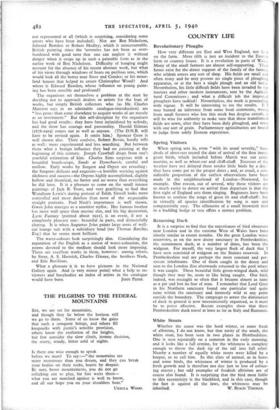ART
British Painting since Whistler. " At the National Gallery.
IN general—a well-arranged exhibition, well worth arranging. But debit side first. The usual mixed-exhibition troubles are here exaggerated. Many individual artists' achievements are distorted. For instance, on this evidence, anyone would be justified in nominating James Pryde as premier British painter of the last seventy years; which would be excessive, though it is as well to be reminded of how good he is. (There has been no opportunity of judging him since his exhibition at the Leicester Galleries some years ago.) A good many artists are not represented fully enough. The Sickens, plentiful and well-chosen as to vintage, are not full-bodied enough as a whole. Nor are the Steers (though A Grey Sea is a special delight and Knucklebones—Walberswick a special surprise). J. D. Innes does not get a square deal. (One painting that flops over into sentiment about evening light ; one that merely documents his influence on the early Augustus John ; and no water-colours.) The Whistlers are not very important.
There are some notable omissions, and near-omissions, particularly among living painters. Sir William Rothenstein is represented by one pastel, 7 by 51 inches. Laura Knight is
not represented at all (which is surprising, considering some artists who have been included). Nor are Ben Nicholson, Edward Bawden or Robert Medley; which is unaccountable. British painting since the 'seventies has not been so over- burdened with good taste that one can neglect it without danger when it crops up in such a palatable form as in the earlier work of Ben Nicholson. Difficulty of hanging might account for the absence of his recent abstract work, but what of his views through windows of boats on perilous seas, which would look all the better near Steer and Conder; or his moor- land houses that helped to create Christopher Wood? And where is Edward Bawden, whose influence on young paint- ing has been sensible and profound?
The organisers set themselves a problenr at the start by deciding not to approach dealers or artists for the loan of works, but simply British collectors who (as Mr. Charles Marriott says in an admirable catalogue-introduction) are " less prone than some elsewhere to acquire works of art merely as an investment." But this self-discipline by the organisers has had good results : they have been intimidated by nobody, and the show has courage and personality. Harold Gilman (1878-1919) comes out as well as anyone. (The D.N.B. will have to be revised again. It omits him.) Spencer Gore is well shown also. Their confrere, Robert Bevan, hardly tells as well: more experimental and less searching. But between them what a benign influence they had on painting at the beginning of this century. Joseph Crawhall drops from one's youthful estimation of him. Charles Sims surprises with a beautiful beach-scape, Sands at Dymchurch, careful and mellow. Early works by Sargent and Orpen are revealing : the Sargents delicate and exquisite—a horrible warning against slickness and success—the Orpens highly accomplished, slightly hollow and theatrical, no better and no worse than everything he did later. It is a pleasure to come on the small intense paintings of Jack B. Yeats, and very gratifying to find that Wyndham Lewis's daring portrait of Edith Sitwell looks more controlled and more dateless than most of the respectable straight portraits. Paul Nash's importance is well shown. Gwen John emerges as a sensitive stylist.. Her famous brother has more wall space than anyone else, and his big decoration, Lyric Fantasy (painted about 1911), is an event, if not a completely pleasant one: beautiful in parts, and distastefully cloying. It is when Augustus John paints large areas of well- cut lounge suit with a subsidiary head (see Thomas Barclay, Esq.) that he seems most brilliant.
The water-colours look surprisingly dim. Considering the reputation of the English as a nation of water-colourists, the rooms devoted to the medium should look more imposing. There afe excellent works in them, however : among others, by Steer, A. S. Hartrick, Charles Ginner, the brothers Nash, and Eric Ravilious.
What a pleasure it is to have pictures in the National Gallery again. And (a very minor point) what a help to re- viewers and busybodies an index of artists in the catalogue















































 Previous page
Previous page